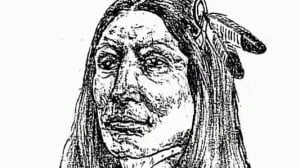Native Chiefs & Leaders: Crazy Horse

TV screenshot of sketch deemed accurate by Crazy Horse’s sister, © PBS History Detective, pub. at http://bit.ly/CrazyHorseSketch
I was thinking about Crazy Horse and what he meant to his people. And what he meant to those he was fighting against. The answer is not simple. There are shrouds of mystery about this man who never had his photograph taken. His year of birth is not agreed upon but occurred sometime around 1842. His death on September 5, 1877 was also shrouded in some mystery as to the circumstances.
What is known with a great deal of surety is that Crazy Horse was revered not just by his own people, but also by chiefs and leaders from other tribes as well as the United States Army. The reasons behind this reverence are complex. Other tribes both feared and respected Crazy Horse as a warrior. The U.S. Army saw him as a threat and a formidable foe.
But, what lies at the base of this is a man, a human being that wanted simply to live as his ancestors had lived… in peace and harmony with the land and tied to the earth and tied to each other through their culture.
Crazy Horse is described as “a gentle warrior, a true brave, who stood for the highest ideal of the Sioux.” He was not a rash, hotheaded warrior who wanted revenge at every possible turn. Rather, he was a warrior and a leader that wanted the best for his people. He wanted to correct a wrong. He simply wanted U.S. officials to observe their obligations with integrity and honesty and treat the Native Americans as equals.
However, his actions on June 25, 1876 have garnered the most attention toward Crazy Horse. For on this day, he defeated General George Armstrong Custer and his 209 men at the Battle of the Little Bighorn. With Crazy Horse as a pivotal leader in that fight, Custer and his men were annihilated. His outstanding offensive tactics have been studied ever since and this battle between the U.S. and Native Americans is one of the most studied in military history.
It may surprise you to know that Crazy Horse was not looking for a fight that day – he simply reacted to the aggressive push of General Custer and his men toward his encampment. Crazy Horse was a man trying to move his people to safety and to live a life unencumbered by the incessant incursion of European settlers. His propensity for thoughtful resolve in times of stress is highlighted in these words of Crazy Horse:
All we wanted was peace and to be left alone. Soldiers came and destroyed our villages. Then Long Hair (Custer) came…They say we massacred him, but he would have done the same to us. Our first impulse was to escape but we were so hemmed in we had to fight.
In closing, I want to leave you with these thoughts: Crazy Horse never signed a peace treaty. He never allowed his picture to be taken. He was never boastful or rash in his manner. He was a leader that led by example, always fighting alongside those in whom he worked to instill hope and never backing down from an opportunity to right a wrong. In short, Crazy Horse was what a great many of us strive to be, a person doing their humble best for their families, their community, and themselves. Crazy Horse wanted to live a traditional life in a tumultuous time of upheaval. He did it the best way he could, given the times and the situation.


One Comment
That is some inspirational stuff. Never knew that opinions could be this varied.